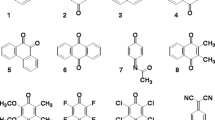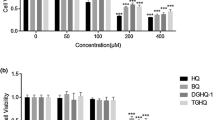Abstract
Quinones can be metabolized by various routes: substitution or reductive addition with nucleophilic compounds (mainly glutathione and protein thiol groups), one-electron reduction (mainly by NADPH: cytochrome P-450 reductase) and two-electron reduction (by D,T-diaphorase). During reduction semiquinone radicals and hydroquinones are formed, which can transfer electrons to molecular oxygen, resulting in the formation of reactive oxygen intermediates and back-formation of the parent quinone (redox cycling). Reaction of semiquinones and reactive oxygen intermediates with DNA and other macromolecules can lead to acute cytotoxicity and/or to mutagenicity and carcinogenicity. The enhanced DNA-alkylating properties of certain hydroquinones are exploited in the bioreductive alkylating quinones. Acute cytotoxicity of quinones appears to be related to glutathione depletion and to interaction with mitochondria and subsequent disturbance of cellular energy homoeostasis and calcium homoeostasis. These effects can to a certain extent be predicted from the electron-withdrawing and electron-donating effects of the substituents on the quinone nucleus of the molecule. Prediction of cytostatic potential remains much more complicated, because reduction of the quinones and the reactivity of the reduction products with DNA are modulated by the prevailing oxygen tension and by the prevalence of reducing enzymes in tumour cells.
Similar content being viewed by others
References
Thomson RA. Distribution of naturally occurring quinones. Pharm Weekbl [Sci] 1991;13:70–3.
Akman SA, Doroshow JH, Dietrich MF, Chlebowski RT, Block JS. Synergistic cytotoxicity between menadione and dicumarol vs. murine leukemia L1210. J Pharmacol Exp Ther 1987;240:486–91.
Miller GM, Rodgers A, Cohen GM. Mechanisms of toxicity of naphthoquinones to isolated hepatocytes. Biochem Pharmacol 1986;35:1177–84.
Redegeld FAM. Hepatic and renal toxicity of xenobiotics: the role of metabolism and transport [Dissertation]. Utrecht: University of Utrecht, 1989.
Thor H, Smith MT, Hartzell P, Bellomo G, Jewell SA, Orrenius S. The metabolism of menadione (2-methyl1,4-naphthoquinone) by isolated hepatocytes. A study of the implications of oxidative stress in intact cells. J Biol Chem 1982;257:12419–25.
Ross D, Thor H, Threadgill MD, et al. The role of oxidative processes in the cytotoxicity of substituted 1,4-naphthoquinones in isolated hepatocytes. Arch Biochem Biophys 1986;248:460–6.
Wilson I, Wardman P, Lin TS, Sartorelli AC. Reactivity of thiols towards derivatives of 2- and 6-methyl- 1,4-naphthoquinone bioreductive alkylating agents. Chem Biol Interact 1987;61:229–40.
Chesis PL, Levin DE, Smith MT, Ernster L, Ames BN. Mutagenicity of quinones: pathway of metabolic activation and detoxification. Proc Natl Acad Sci USA 1984;81:1696–700.
George CF, Shand DG, Renwick AG, eds. Presystemic drug elimination. London: Butterworth, 1981.
Koster AS, Richter E, Lauterbach F, Hartmann F, eds. Intestinal metabolism of xenobiotics. Stuttgart: Gustav Fischer Verlag, 1989. (Eichelbaum FM, Forth W, Meyer U, Van Zwieten PA, eds. Progress in pharmacology and clinical pharmacology; vol. 7. No. 2.)
Talalay P, De Long MJ, Prochaska HJ. Molecular mechanisms in protection against carcinogenesis. In: Cory JG, Szentivanyi A, eds. Cancer biology and therapeutics. New York: Plenum Press, 1987:197–216.
Rossi L, Moore GA, Orrenius S, O'Brien PJ. Quinone toxicity in hepatocytes without oxidative stress. Arch Biochem 1986;251:25–35.
Gant TW, Ramakrishna Rao DN, Mason RP, Cohen GM. Redox cycling and sulphydryl arylation; their relative importance in the mechanism of quinone cytotoxicity to isolated hepatocytes. Chem Biol Interact 1988;65:157–73.
Boobis AR, Fawthrop DJ, Davies DS. Mechanisms of cell death. TiPS 1989;10:275–80.
Lepoittevin J-P, Benezra C. Allergic contact dermatitis caused by naturally occurring quinones. Pharm Weekbl [Sci] 1991;13:119–22.
Powis G. Metabolism and reactions of quinoid anticancer agents. Pharmacol Ther 1987;35:57–162.
Kappus H, Sies H. Toxic drug effects associated with oxygen metabolism: redox cycling and lipid peroxidation. Experientia 1981;37:1233–58.
Lind C, Hochstein P, Ernster L. D,T-diaphorase as a quinone reductase: a cellular control device against semiquinone and Superoxide radical formation. Arch Biochem Biophys 1982;216:178–85.
Bock KW, Lilienblum W, Fischer G, Schirmer G, Bock-Hennig BS. The role of conjugation reactions in detoxication. Arch Toxicol 1987;60:22–9.
Floridi A, Castiglione S, Bianchi C. Sites of inhibition of mitochondrial electron transport by rhein. Biochem Pharmacol 1989;38:743–51.
Richter C, Frei B. Ca2+ release from mitochondria induced by prooxidants. Free Rad Biol Med 1988;84:363–75.
Moore GA, Rossi L, Nicotera P, Orrenius S, O'Brien PJ. Quinone toxicity in hepatocytes: studies on mitochondrial Ca2+ release induced by benzoquinone derivatives. Arch Biochem Biophys 1987;259:283–95.
Stubberfield CR, Cohen GM. Interconversion of NAD(H) to NADP(H). A cellular response to quinoneinduced oxidative stress in isolated hepatocytes. Biochem Pharmacol 1989;38:2631–7.
Orrenius S, McConkey DJ, Bellomo G, Nicotera P. Role of Ca2+ in toxic cell killing. TiPS 1989;10:281–5.
D'Arcy Doherty M, Rodgers A, Cohen GM. Mechanisms of toxicity of 2- and 5-hydroxy-1,4-naphthoquin-one; absence of a role for redox cycling in the toxicity of 2-hydroxy-1,4-naphthoquinone to isolated hepatocytes. J Appl Toxicol 1987;7:123–9.
Kennedy KA. Hypoxic cells as specific drug targets for chemotherapy. Anticancer Drug Design 1987;2:181–94.
Lusthof KJ, Groothuis-Pielage IL, Decuyper J, et al. Potential anti-tumour 2,5-bis(1-aziridinyl)-1,4-benzoquinones: relationship between cytotoxicity against DNA-repair deficientE. coli, inactivation of bacteriophage M13mp19, andin vitro andin vivo anti-tumour activity. Anticancer Drug Design 1988;3:147–55.
Author information
Authors and Affiliations
Additional information
This article is based on a lecture given at the 16th LOF Symposium, 27 October 1989, Utrecht, the Netherlands.
Rights and permissions
About this article
Cite this article
Koster, A.S. Bioreductive activation of quinones: A mixed blessing. Pharmaceutisch Weekblad Scientific Edition 13, 123–126 (1991). https://doi.org/10.1007/BF01981528
Accepted:
Issue Date:
DOI: https://doi.org/10.1007/BF01981528




